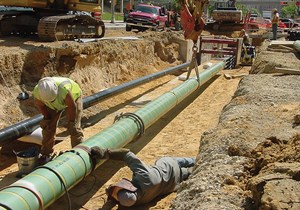August 2024 Vol. 79 No. 8
Washington Watch
Washington Watch: Congress stalls on pipeline safety bill as PHMSA nears key rule decisions

By Stephen Barlas, Contributing Editor, Washington, D.C.
(UI) — As Congress heads toward the end of this session, presumably in late September, the two, different bipartisan pipeline safety bills passed by two House committees appear to be going nowhere fast.
But that may not matter much because the provisions in those two bills pale in importance to what is going on behind the scenes at the federal pipeline safety agency. It is trying to wrestle into final shape two important safety rules dictated by previous congressional pipeline safety bills.
The Pipeline Safety and Hazardous Materials Safety Administration (PHMSA) is apparently in the final stages of issuing rules on when pipelines can use integrity management in Class 3 areas and another on leak detection. Both have been authorized by prior congressional legislation and long delayed.
The class location rulemaking has ebbed and flowed over a decade with a proposed rule issued in October 2020 and nothing since. A valve leak proposed rule was issued in May of 2023 as the result of a 2020 congressional pipeline safety bill. PHMSA is accepting comments on those potential new regulations through August, after which final rules will be adopted.
PHMSA has been dawdling over those past congressional requirements just as the House has put together a new pipeline safety bill. The House Transportation and Infrastructure Committee passed the PIPES Act of 2023 (H.R. 6494) in December 2023. A second House Committee, Energy & Commerce, passed a different pipeline safety reauthorization bill in March 2024 called Pipeline Safety, Modernization and Expansion Act of 2024 (H.R.7655).
The E&C bill has a number of semi-important provisions the T&I bill does not have. These include preventing PHMSA from ordering pipelines to reconfirm MAOP under certain conditions and making it easier to get approval from the Federal Energy Regulatory Commission for a new pipeline being co-located in a previously used right-of way. On the other hand, the bill also expands the authority of PHMSA to issue penalties to pipelines, adding the term “impairing” to the current language of allowing penalties only for “damaging and destroying.”
One of the similar provisions in both bills instructs PHMSA to issue a final rule on class location 90 days after final passage. Rep. Troy Nehls (R-Texas), chairman of the Railroads, Pipelines and Hazardous Materials Subcommittee, complained in May 2024: “Despite such action in the House, we have yet to see any movement in the Senate from Leader Schumer and his majority.”
Justin Harclerode, spokesman for the T&I committee, said, “Since they are separate components/bills, we’re still discussing the path to floor consideration with E&C.”
Allowing operators to use IM when an area goes from Class 1 to Class 3, because of increased population, has been at the top of the industry’s wish list for a number of years. Class location requirements are expensive and time consuming, forcing some pipelines to instead file petitions at PHMSA for special permits.
On Jan. 18, 2024, Amy Andryszak, president & CEO, Interstate Natural Gas Association of America (INGAA), wrote to Jeff Duncan (R-S.C.), chairman of the House energy subcommittee, “INGAA’s top regulatory priority with PHMSA is completion of the class location rulemaking, which presents opportunities to increase safety and protect the environment.”
While the new pipeline bills sit vegetatively in Congress, the class location and leak detection proposed rules are the target of battles at PHMSA between the pipeline industry, PHMSA Gas Pipeline Advisory Committee (GPAC) and environmental groups. GPAC met once in late 2023 and then again in late March 2024 to hash out particulars of the two imminent rules. Interest groups weighed in during the meetings in an effort to sway PHMSA officials who were there. Pipeline companies face an end of August 2024 deadline for submitting comments based on the discussions at the March GPAC meeting.
On use of IM instead of class location, one of the major bones of contention is whether “bad actors” should automatically be ineligible to use IM in Class 3 areas. That suggestion came from Sara Rollet Gosman, University of Arkansas School of Law, a member of GPAC. She suggested that a pipeline company be barred for five years if the company had a “significant incident, and PHMSA has taken an enforcement action and determined that there’s been a violation” of the IM regulation.
Members of GPAC from pipeline companies had no problem with the concept of barring bad actors. But Chad Zamarin, executive vice president, corporate strategic development, Williams, argued the definition of “significant incident” is very broad. He offered that companies PHMSA deems don’t have the capability to effectively implement the program shouldn’t be implementing the program and should be barred.
“The definition of significant incident is very broad,” he cautioned. “It’s any incident that crosses several criteria, including one that is a very small amount of volume.”
Erin Murphy, Environmental Defense Fund, another member of GPAC, called Gosman’s proposal “really reasonable” and supported broadening it.
Pete Chace, Public Utilities Commission of Ohio, who was representing the National Association of Pipeline Safety Representatives, argued PHMSA already has the authority to penalize “bad actors.”
Alan Mayberry, PHMSA associate administrator, said at the GPAC meeting that there are no “bad actor” provisions anywhere in the agency’s rules. He added, “But we have our authority and a variety of tools that are at our disposal.”
Gosman also raised opposition to allowing segments moving to IM in Class 3 areas if there were “geohazards” affecting that section of pipe, she said, expanding on concerns raised by the National Transportation Safety Board (NTSB).
It’s really about focusing on the fact that we do not want to have segments in this program where there is a geohazard,” she stated. Geohazards refer to adverse soil conditions, weather and other natural conditions which affect pipeline safety.
Mayberry answered, “It’s definitely safe to say that this is on our radar. And it’s under consideration for future rulemaking.”
The proposed leak detection/reporting rule comprised numerous provisions including reporting on large volume leaks, which would be new. The final rule, based on GPAC discussions, is likely to include a quarterly-report requirement listing leaks over that period of 0.5 million cubic feet (MMCF) within four to 10 days or 100-kilograms-per-hour flow rate.
The rule will include a new methodology for “leak grading” and the question there is the compliance deadline. Lauren Toczylowski, a project manager with Con Edison, explained, “The final rule will require sweeping changes to the way we perform leak surveys, the equipment we use, and the practices of leak grading, the majority of which will require operators to investigate and procure new equipment, modify extensive IT and software programs, modify and expand training programs, and change operator qualification.”
PHMSA had originally supported a six-month compliance deadline, from publication of a final rule. But numerous industry executives from both interstate and distribution pipeline companies said that was far too short a period given the complexities of compliance. Many supported three years.
Ann Jaworski, senior associate attorney with Earthjustice, backed six months. But she said she would “support a compliance deadline that would be as soon as practicable and shorter than the three-year deadline that some industry commenters have suggested.”





Comments